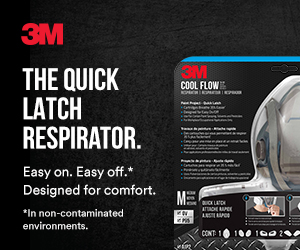 Jason Lunn is a 3M application engineering specialist for consumer safety products. He oversees the training and educational aspect of a wide variety of safety products, including respirators. Here, he tackles a question painting professionals may have about cartridges and filters for reusable respirators.
Jason Lunn is a 3M application engineering specialist for consumer safety products. He oversees the training and educational aspect of a wide variety of safety products, including respirators. Here, he tackles a question painting professionals may have about cartridges and filters for reusable respirators.
Q: How do I know which reusable respirator cartridge or filter to select for a job?
A: In order to make the right decision, you’ll first need to conduct a hazard assessment to determine what you are being exposed to and in what concentrations. To do so, you have a couple of options: you can either hire an Industrial Hygienist, or have one done for free through OSHA’s consultation services. The hazard assessment will help you determine if you are being exposed to gases, vapors, particulates, or a combination of those. Regardless of who does your assessment though, basic information about both cartridges and filters will help you understand what they are and why you should use certain ones.
Here’s a brief overview: Cartridges are designed to help filter out certain gases and vapors, while filters help filter out particulates.
For the painting professional, solvents in paints or from cleaning solutions can evaporate as ‘organic vapors.’ Particulates include dust from sanding and buffing, and mists from spraying. Let’s first tackle the question of how filters help protect you from potentially harmful particulates.
Filter ratings use letters and numbers to help determine what type of filtration they can provide. There are three letters (N, R and P), and three numbers (95, 99 and 100). The letters speak to a filter’s ability to help protect against oil-based particulates. N stands for ‘not resistant,’ R for ‘resistant’ and P for ‘proof.’ If you have an N-rated filter, for example, it is not resistant to oil-based particulates, but works well for things like dust, debris and most painting applications. R- and P-rated filters may be used for both oily and non-oily aerosols.
Filter ratings also include a number, which is the filtration efficiency per the government certification test. A 95-level filter is typically used to filter most types of dust as well as the aerosolized mist associated with paint spraying. A 100-class filter is required by OSHA for substance-specific hazards such as lead and asbestos.
Cartridges can help protect against many types of gases and vapors. Organic vapors typically can be found in products like paints, thinner, solvent-based epoxy and urethanes. Cartridges approved for filtering organic vapors have a black label. Cartridges approved for filtering both organic vapors and acid gases have a yellow label.
When spraying solvent-based paints, you will need both a particulate filter and an organic vapor cartridge. The particle filter is sometimes called a ‘pre-filter’ because it sits on top of the cartridge and helps filter out the particulates before the air moves into the cartridge. They are often made with non-woven strands of material that have been electrostatically charged to help attract and capture particles as air is pulled through the filter when you inhale. The air then passes into the chemical cartridge, which is filled with carbon granules that may also have been chemically treated to help absorb specific gases from the air. As you can see, these are two completely different filtration technologies, which is why it’s important to use both a filter and a cartridge when your hazard assessment calls for both.
Keep in mind, if your airborne hazard consists only of particulates (for example, from sanding drywall), you can use a standalone particulate filter that attaches directly to the facepiece. On the other hand, if your exposure only consists of organic vapors (such as rolling and brushing paint, where you don’t have the spray mist), an organic vapor cartridge can be used by itself.
Last, but not least, the right filter and cartridge choices are wasted if the respirator is not assembled correctly, does not fit properly, is worn over a beard, etc. So, make sure to read and follow all user instructions for your specific respirator.
To learn more visit the 3M Center for Respiratory Protection or to find product visit 3M.com/RespiratorsReusable




